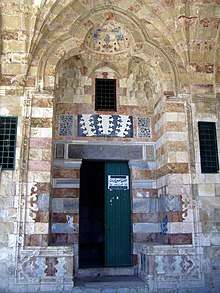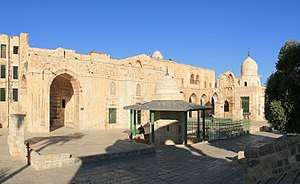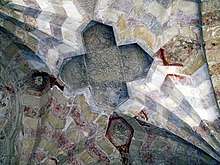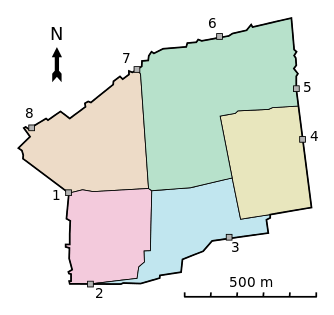Madrasa Al-Ashrafiyya
The Madrasa Al-Ashrafiyya (Arabic: مدرسة الأشرفية) is an Islamic madrasa[1] structure built in 1480-1482 by the Mamluk sultan al-Ashraf Qaytbay[2] [3](after whom it is named) on the western side of the Haram al-Sharif (Temple Mount) in Jerusalem. Although only a part of the original structure is still standing today, it is a notable example of royal Mamluk architecture in Quds.[4]
| The Madrasa Al-Ashrafiyya مدرسة الأشرفية | |
|---|---|
 Main portal of the madrasa, with Mamluk ornamentation. | |
| Religion | |
| Affiliation | Islam |
| Patron | Sultan Qaytbay |
| Location | |
| Location | Temple Mount, Jerusalem |
| Geographic coordinates | 31°46′39.12″N 35°14′3.6″E |
| Architecture | |
| Type | Madrasa |
| Style | Mamluk architecture Islamic |
| Completed | 1482 CE |
| Materials | stone |
History

Al-Ashraf Qaytbay was one of the last powerful and successful sultans of the Mamluk Empire which ruled from Cairo, Egypt. He was originally a mamluk purchased by Sultan al-Ashraf Barsbay (ruled 1422–1438) and served under several Mamluk sultans. Qaytbay succeeded Timurbugha as sultan at the age of 54, and ruled for nearly 29 years from 1468 to 1496, the second-longest reign of any Mamluk sultan (after al-Nasir Muhammad). Despite rebellions and other challenges, he is known as an effective ruler who brought long-term stability while he remained in power, and is especially notable as one of the greatest patrons of architecture in the Mamluk period, and particularly of the Burji Mamluk period which was otherwise marked by Egypt's relative decline.[5] He is known for at least 85 structures which he built or restored in Egypt, Syria, Palestine, and Mecca, including 17 in Cairo, and this period is characterized by a refinement of the Mamluk architectural style.[6]
In 1478 CE (883 AH), Qaitbay endowed a quarter of the revenues of Mulabbis to two newly established institutions: Madrasa Al-Ashrafiyya, and a mosque in Gaza.[7]
Qaytbay's new madrasa was built between 1480 and 1482 CE.[8] As Qaytbay estimated that local craftsmanship did not live up to his standards, he commissioned a team of builders and artisans, including a Coptic architect from Cairo to work on this project.[9] This marks a relatively rare occasion where a Mamluk sultan commissioned a construction project of such significance outside of Cairo.[8]Just three months after the completion of the madrasa, Qaytbay then ordered the sabil (fountain house or water dispensary) to its northeast to be rebuilt, resulting in the Sabil of Qaytbay still standing there today.[8]
A strong earthquake destroyed much of the upper floor of the madrasa in 1496.[9] Today, only parts of the lower stories have survived, but the original structure is known thanks to extensive contemporary documentation and modern-day investigation of its remains.[8]
Architectural description

The madrasa was built on two stories on the western side of the Al-Haram Al-Sharif, facing towards the Dome of the Rock. The facade of the building is 25 meters wide and projects in front of the long arcade which runs along the western boundary of the Haram al-Sharif, which would have made the madrasa very prominent, a feature likely owed to its royal patronage.[8] The madrasa is bounded on the north side by the 15th-century Uthmaniyya Madrasa[10], while to the south rises the minaret of Bab al-Silsila.
According to Mujīr al-Dīn al-'Ulaymī, who was a historian at that time, it is a third jewel of Masjid Bayt al-Maqdis (Al-Haram Al- Sharif) after al-Aqsa Mosque and the Dome of the Rock.[11][12]
The madrasa was centered around a large rectangular courtyard similar to those built by Qaytbay earlier at his own funerary mosque-madrasa in Cairo and in other late Mamluk madrasas of the period. However, the eastern side of the courtyard was taken up by a triple-arched loggia which, thanks to its elevated position, provided an unimpeded view of the Dome of the Rock. Living quarters for students were arranged around another upper courtyard or terrace built over the adjacent Baladiyya Madrasa.[8][9]
References
| Wikimedia Commons has media related to Madrasah al-Ashrafiyya. |
- Abu Shammalah, Sharif Amin (2019). Bayt Al-Maqdis: A short History From Ancient To Modern Times in "Al-Quds History, Religion and Politics". Ankara: SETA. p. 56. ISBN 9786057544773.
- Smith, Andrew. "Mamluk Jerusalem: Architecturally Challenging Narratives". A Journal of Transdisciplinary Writing and Research from Claremont Graduate University. 3(1).
- Al-Natsheh, Yusuf Said. "Al-Madrasah al-Sallamiyya (al-Mawsiliyya) History, Architecture, Methods of Restoration and Rehabilitation". Welfare Association-Old City of Jerusalem Revitalization Programme: 1–117.
- "Discover Islamic Art - Virtual Museum - monument_ISL_pa_Mon01_8_en". islamicart.museumwnf.org. Retrieved 2020-04-21.
- Raymond, André. 1993. Le Caire. Fayard.
- Williams, Caroline (2018). Islamic Monuments in Cairo: The Practical Guide (7th ed.). Cairo: The American University in Cairo Press. p. 289.
- Marom, 2019, p. 138
- Blair, Sheila S.; Bloom, Jonathan (1995). The Art and Architecture of Islam: 1250-1800. New Haven; London: Yale University Press. pp. 92–93.
- "Madrasa al-Ashrafiyya". Archnet. Retrieved 2019-10-23.
- Burak, Guy (2013). "Dynasty, Law, and the Imperial Provincial Madrasa: The Case of al-Madrasa al-'Uthmaniyya in Ottoman Jerusalem". International Journal of Middle East Studies. 45: 111–125. doi:10.1017/S0020743812001286.
- Little, Donald P. (1995). "Mujīr al-Dīn al-ʿUlaymī's Vision of Jerusalem in the Ninth/Fifteenth Century". Journal of the American Oriental Society. 115 (2): 237–247. doi:10.2307/604667. JSTOR 604667.
- Necim, Raif. "İsrail İşgaline Rağmen Kudüs'te İslam Mimari Mirasının Korunması". The Conference on the Preservation of Architectural Heritage of Islamic Cities: 473–479.
Bibliography
- Berchem, van, M. (1922). MIFAO 43 Matériaux pour un Corpus Inscriptionum Arabicarum Part 2 Syrie du Sud T.1 Jérusalem "Ville" (in French and Arabic). Cairo: Impr. de l'Institut français d'archéologie orientale. (pp. 352−374)
- Burgoyne, Michael Hamilton (1987). Mamluk Jerusalem. ISBN 090503533X. (pp. 589−605)
- Hawari, M.; Yusuf Natsheh; Nazmi Al-Ju'beh (2013). Pilgrimage, Sciences and Sufism: Islamic Art in the West Bank and Gaza. Museum With No Frontiers, MWNF. ISBN 978-3902782113. (pp. 88–90)
- Marom, Roy (2019). "A short history of Mulabbis (Petah Tikva, Israel)". Palestine Exploration Quarterly. 151 (151:2): 134–145. doi:10.1080/00310328.2019.1621734.
- Moudjir ed-dyn (1876). Sauvaire (ed.). Histoire de Jérusalem et d'Hébron depuis Abraham jusqu'à la fin du XVe siècle de J.-C. : fragments de la Chronique de Moudjir-ed-dyn. (p. 143)
- Tibawi, A.L. (1978). The Islamic Pious Foundations in Jerusalem: Origins, History and Usurpation by Israel. London: Islamic Cultural Centre.
External Links
- Madrasa al-Ashrafiyya at Discover Islamic Art (Museum With No Frontiers) (includes more pictures and a floor plan)
- Madrasa al-Ashrafiyya at ArchNet
- Madrasa al-Ashrafiyya Restoration, archnet

